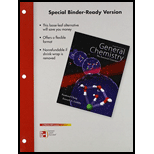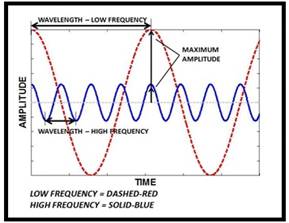
Interpretation:
The terms wave, wavelength, frequency and amplitude should be explained with a neat diagram.
Concept Introduction:
A wave is a disturbance or variation that travels through a medium transporting energy without transporting matter.
The wavelength is the distance between identical points on successive waves.
The frequency is the number of waves that pass through any particular point in one second.
The amplitude is the vertical distance from the midline of a wave to the top of the peak or the bottom of the trough.
Explanation of Solution
The wave can be in any forms which are shown in the below diagram.

Figure.1
The wavelength is the distance between identical points on successive waves which are shown both in high and low frequency waves.

Figure.2
The frequency is the number of waves that pass through any particular point labelled as

Figure.3
The amplitude is the vertical distance from the midline of a wave to the top of the peak or the bottom of the trough which is clearly shown in left side of figure4 diagram. In the right side diagram, both high and low amplitude waves are shown.

Figure.4
The terms wave, wavelength, frequency and amplitude are explained with a neat diagram.
Want to see more full solutions like this?
Chapter 7 Solutions
Loose Leaf For General Chemistry With Connect Access Card
 ChemistryChemistryISBN:9781305957404Author:Steven S. Zumdahl, Susan A. Zumdahl, Donald J. DeCostePublisher:Cengage Learning
ChemistryChemistryISBN:9781305957404Author:Steven S. Zumdahl, Susan A. Zumdahl, Donald J. DeCostePublisher:Cengage Learning ChemistryChemistryISBN:9781259911156Author:Raymond Chang Dr., Jason Overby ProfessorPublisher:McGraw-Hill Education
ChemistryChemistryISBN:9781259911156Author:Raymond Chang Dr., Jason Overby ProfessorPublisher:McGraw-Hill Education Principles of Instrumental AnalysisChemistryISBN:9781305577213Author:Douglas A. Skoog, F. James Holler, Stanley R. CrouchPublisher:Cengage Learning
Principles of Instrumental AnalysisChemistryISBN:9781305577213Author:Douglas A. Skoog, F. James Holler, Stanley R. CrouchPublisher:Cengage Learning Organic ChemistryChemistryISBN:9780078021558Author:Janice Gorzynski Smith Dr.Publisher:McGraw-Hill Education
Organic ChemistryChemistryISBN:9780078021558Author:Janice Gorzynski Smith Dr.Publisher:McGraw-Hill Education Chemistry: Principles and ReactionsChemistryISBN:9781305079373Author:William L. Masterton, Cecile N. HurleyPublisher:Cengage Learning
Chemistry: Principles and ReactionsChemistryISBN:9781305079373Author:William L. Masterton, Cecile N. HurleyPublisher:Cengage Learning Elementary Principles of Chemical Processes, Bind...ChemistryISBN:9781118431221Author:Richard M. Felder, Ronald W. Rousseau, Lisa G. BullardPublisher:WILEY
Elementary Principles of Chemical Processes, Bind...ChemistryISBN:9781118431221Author:Richard M. Felder, Ronald W. Rousseau, Lisa G. BullardPublisher:WILEY





